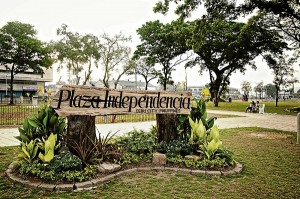No more fright nights at historic plaza

PEOPLE now frequent Plaza Independencia, a former military training and parade ground, after the historic landmark underwent renovation in October 2010. IMAR ORACION
Jervi Rasul, 29, had avoided going to Plaza Independencia in Cebu City’s downtown area. The historical landmark, he thought, was a dangerous place where robbers and snatchers lurked, ready to pounce on victims.
His fear was not without basis. Police authorities even classified the dim plaza and streets branching from it as crime-prone because of several holdup and snatching cases that happened there.
The image was quite ironic considering that the place near the waterfront used to be a military training and parade ground during the Spanish colonial times.
Plaza Independencia, which is in front of two other landmarks—the Magellan’s Cross and the Basilica Minore del Sto. Niño—is just a stone’s throw away from a police station and a few meters from city hall. But it was one place that Rasul avoided even though it is beside the government agency where he worked.
Renovation
Article continues after this advertisementA change in attitude came on May 8, when the plaza was reopened to the public after undergoing renovation since October last year.
Article continues after this advertisement“I finally saw a landscaped garden. The place no longer has urine stench. Comfort rooms were well-maintained. The grass is greener and the fences are restored,” said Rasul, a native of Surigao City who has lived in Cebu City for 13 years.
The makeover might have been providential because two months after the formal reopening, Cebu was declared an Association of Southeast Asian Nations “City of Culture.”
“The city government envisions Cebu to become the best example of historical conservation and renewal in the country,” said Dr. Librado Macaraya, chair of the city’s parks and playground commission.
According to him, Cebu City dreams of establishing Heritage Village, a vast historical complex, with Plaza Independencia and the adjacent Fort San Pedro as centerpieces. The fort was built when the Spaniards led by Miguel Lopez de Legazpi came.
The city spent P37.2 million for the renovation of the plaza and P3.3 million for the rehabilitation of the stage and playground.
Name changes
Macaraya said Plaza Independencia’s role in the history of Cebu “is reflected in the evolution of its name.”
Established in 1600, it was first named Plaza de Armas, a public square used as military training ground. When it expanded to reach the Cebu Cathedral, it was called Plaza Mayor. Later, it was christened Plaza Maria Cristina, in honor of the colonizers’ queen at that time.
The American colonizers changed it to Plaza Libertad. When they and the Japanese occupation forces left the Philippines after World War II, the place acquired its present name.
Macaraya said that during the US colonial period, “the park was more spacious with the whole area beautifully fenced and no ground elevations to block the view. It also employs simple landscaping with less structures.”
A gazebo is located at the center.
Historical artifacts
Several diggings made in the plaza and its adjacent areas yielded artifacts indicating the existence of a precolonial trading port called Sugbo. Burials with earthenware and ceramics from China, Thailand and Vietnam were excavated.
Ancient human bones and other earthen utensils were found during the construction of an underground tunnel connecting to the South Coastal Road in 2006.
Because of Plaza Independencia’s large area of some 2.5 hectares, constant monitoring of its security is needed. Macaraya said two security guards had been hired for each of the three shifts, while four members of the barangay intelligence network were posted at the perimeter fence and comfort rooms.
Today, Rasul jogs every other afternoon around the plaza’s paved path, which is a good alternative to the roads.
“(With the new look), I have seen students and joggers frequent the plaza. We like people to view Plaza Independencia as a park intended for rest and recreation and for people to feel secure while they’re spending their time here,” Macaraya said.